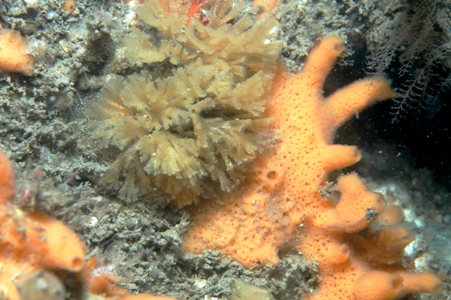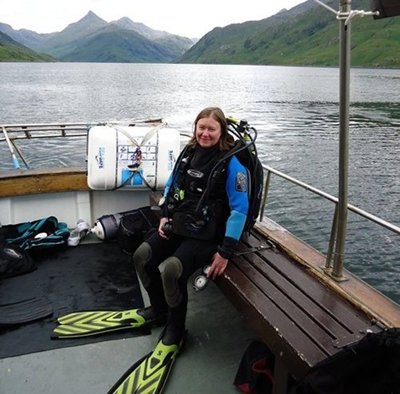My early encounters with the marine environment would most certainly have taken place during family holidays, when as a child I would happily forage in rock pools and along the strandline during the two weeks of the ‘Potters Fortnight’, when each year our whole family travelled with caravans in a convoy down to Newlyn in Cornwall. Many contented hours would be spent collecting snails and looking for dried up treasures that had been washed up. As we lived about as far away from the ocean as is possible in the UK mainland, these annual vacations to Cornwall or long weekend trips to the coast of mid Wales constituted my experience of the sea and its inhabitants.
Later in life, when I reached the City of Stoke on Trent Sixth Form College and had to make decisions about what to study and what to do after A-levels, it became apparent that a degree involving natural sciences would be my best option. My tutor suggested that I should consider Horticulture or Marine Biology. I eagerly perused the prospectuses section of the library, scouring the pages for information about the different possible establishments that offered the subjects of interest. After much deliberation, I decided that Newcastle University was my prime choice, as it had not only a sea going research vessel, but also its own laboratory, named after Eleanor Dove, based on the North East coast at Cullercoats. In September 1990 I headed north to my new home for the next 3 years in Newcastle and settled in to my studies. Having always been a keen walker and lover of wildlife, I soon got into my stride and enjoyed our class outings to the field.
In one of our courses, we spent time each week at the Dove Marine Laboratory working our way through the different animal phyla of marine invertebrates. It was during one of these sessions with tutor Judy Foster-Smith that I was first introduced to the fascinating creatures known as Bryozoa or sea mats. With the naked eye, these colony forming animals look very much like lichens or mosses, coating rocks, shells or seaweeds with either a gelatinous or a calcified layer. Under the microscope however, a whole new world opens up, revealing the true nature of these architectural experts. Each colony is composed of a number of units (known as zooids), joined together to form a shared skeleton. Some of the zooids are adapted for feeding, others for reproduction and others for defence. I remember thinking how fascinating it was to see the intricate structures and how organised the animal was, as I looked down the microscope at the different specimens laid out for us to observe.

It was towards the end of my third year at Newcastle University that my sights moved towards the future and I was keen to pursue a career in academia as a marine scientist. I was looking for an opportunity to take up a PhD position and by chance an opportunity came up at Swansea University to study the reproduction and genetics of marine Bryozoa with Professor John Ryland and Dr Gary Carvalho. In the autumn of 1994 I relocated to south Wales and started work on my new project, at the School of Biological Sciences.
I was fortunate during those PhD years, to be a member of an active group of expert researchers focussed on different aspects of the Bryozoa and a keen group of geneticists. I was privileged to spend the next few years in the company of these experts and enjoyed the chance to study to a deep level the biology and evolution of a specific genus, within the gelatinous or Ctenostome Bryozoa, called Alcyonidium. My study of this genus continued through my PhD years when I studied species from British coastal waters, and on into my postdoctoral years when I studied a collection of material sent from Antarctica and the Magellan Strait. During this period, with my advisers Dr Peter Hayward and professor David Skibinski I described several new species, and revised descriptions of others. A combination of morphological, reproductive and genetic characteristics was used to delineate the species boundaries.
During my second period of postdoctoral study, my interests expanded to encompass calcified as well as gelatinous Bryozoa and I spent a lot of time trying to develop molecular markers with the aim of constructing a phylogenetic framework for the Phylum. Another interest that developed during this time was that of the ecology and symbiotic associations of the Bryozoa. I had become a SCUBA diver during my PhD years, and having spent several years enjoying recreational dives I was becoming skilled enough to start doing dives with a scientific purpose. I joined the Marine Conservation Society’s Seasearch volunteer program with a view to improving surveying skills and I bought myself an underwater camera. The ability to dive opened up the chance to see what subtidal Bryozoa actually did in real life, where they could be found, and how they interacted with other members of the marine community, across a range of habitats. From genetic research I knew that Bryozoa colonies provide homes to a wide variety of microbial symbionts, and this has blossomed into a further research avenue.
 Following my postdoctoral research I took up a lecturing post at Aberystwyth University, and after 5 years then moved up to Heriot Watt University to join the Centre for Marine Biodiversity and Biotechnology in July 2009. As an active member of the Scientific Dive Team, much survey work is undertaken and in combination with the Seasearch diving expeditions, many more records of marine Bryozoa are now becoming available. Four years ago I was approached by Chris Wood, National Seasearch Coordinator to write a Seasearch Guidebook on Bryozoa and Hydroids, with the aim of helping volunteers to distinguish between the two groups and to improve the quality and quantity of records going forward to Marine Recorder and ultimately the National Biodiversity Network Gateway. This guidebook was published in June 2012, and I hope that many people will find it both useful and enjoyable. I am optimistic that much new information will come into the NBN as volunteers and practitioners alike are empowered to develop their in situ ID skills on these commonly found, but difficult to identify groups.
Following my postdoctoral research I took up a lecturing post at Aberystwyth University, and after 5 years then moved up to Heriot Watt University to join the Centre for Marine Biodiversity and Biotechnology in July 2009. As an active member of the Scientific Dive Team, much survey work is undertaken and in combination with the Seasearch diving expeditions, many more records of marine Bryozoa are now becoming available. Four years ago I was approached by Chris Wood, National Seasearch Coordinator to write a Seasearch Guidebook on Bryozoa and Hydroids, with the aim of helping volunteers to distinguish between the two groups and to improve the quality and quantity of records going forward to Marine Recorder and ultimately the National Biodiversity Network Gateway. This guidebook was published in June 2012, and I hope that many people will find it both useful and enjoyable. I am optimistic that much new information will come into the NBN as volunteers and practitioners alike are empowered to develop their in situ ID skills on these commonly found, but difficult to identify groups.
Joanne Porter, Senior Lecturer in Marine Biology, Centre for Marine Biodiversity and Biotechnology, Heriot Watt University.
